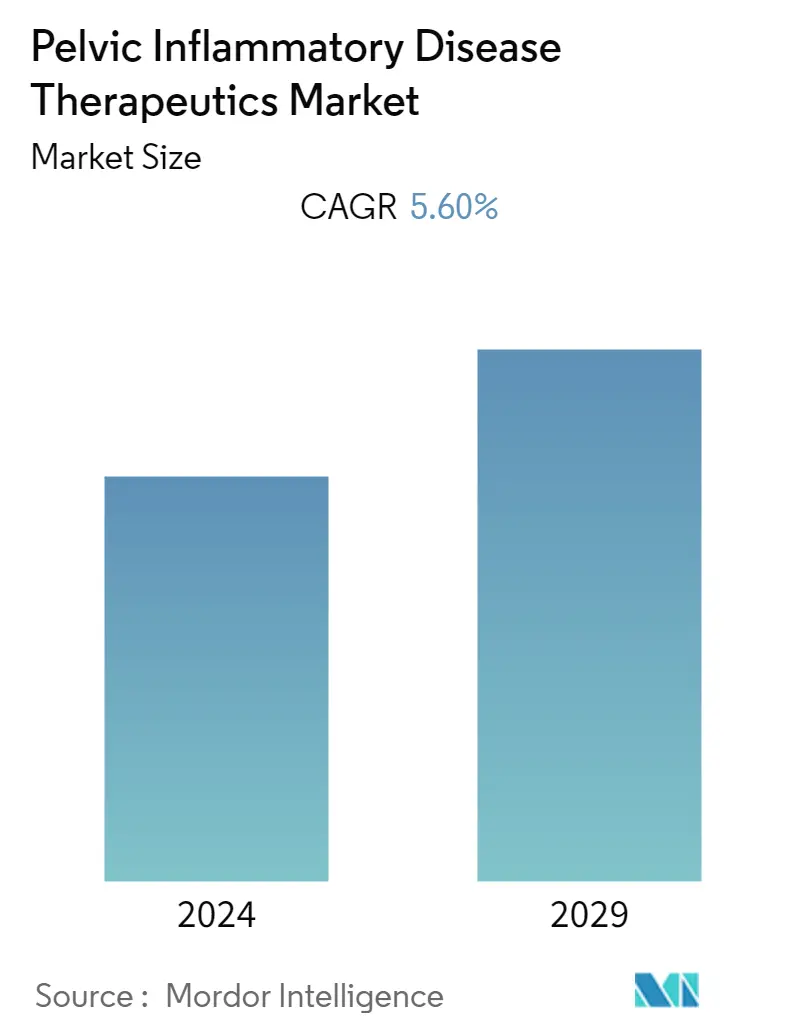Market Size of Pelvic Inflammatory Disease Therapeutics Industry

| Study Period | 2019 - 2029 |
| Base Year For Estimation | 2023 |
| CAGR | 5.60 % |
| Fastest Growing Market | Asia Pacific |
| Largest Market | North America |
| Market Concentration | Medium |
Major Players
*Disclaimer: Major Players sorted in no particular order |
Need a report that reflects how COVID-19 has impacted this market and its growth?
Pelvic Inflammatory Disease Therapeutics Market Analysis
The pelvic inflammatory disease therapeutics market studied was anticipated to witness a CAGR of 5.6% during the forecast period.
The studied market was adversely impacted by the pandemic. Various research studies provide insight into the impact of the pandemic on the market. According to the article titled, 'Sexually transmitted infections during the COVID-19 outbreak: comparison of patients referring to the service of sexually transmitted diseases during the sanitary emergency with those referring during the common practice' was published by researchers based in Italy in June 2020. It stated that before the national lockdown in Italy, a total of 1,081 medical provisions were delivered by the STDs Service of Dermatology, Bologna. The percentage of visits for prophylaxis declined during and after the lockdown, while visits for syphilis, gonococcal pharyngitis, and inflammatory genital diseases increased significantly. As per the article titled, 'Measuring the Impact of the COVID-19 Pandemic on Sexually Transmitted Diseases Public Health Surveillance and Program Operations in the State of California', published in August 2020, a comparative study for January-June 2020 to January-June of 2019 data found that there were decreases in reported cases of chlamydia (31%), late syphilis (19%), primary/secondary syphilis (15%), early nonprimary non-secondary syphilis (14%), and gonorrhea (13%) during the COVID-19 pandemic. Thus, the market was adversely impacted by the pandemic.
The major factors attributing to the growth of the market are a rise in urinary tract infections, sexually transmitted diseases (STDs), and severe complications associated with pelvic inflammatory diseases (PID), such as increased rate of Polycystic ovary syndrome (PCOS) cases, and infertility. According to the article by Ayan Sabih and Stephen W. Leslie, published by the National Institute of Health in February 2021, complicated UTI incidence was highly associated with specific risk factors. For instance, there is a 10% estimated daily risk of developing bacteriuria with indwelling bladder catheters, and there is up to a 25% risk that bacteriuria will progress to a urinary tract infection. In June 2022, the Centers for Disease Control and Prevention recommended and issued guidelines for screening sexually transmitted diseases to create awareness toward screening programs for STDs and the increasing burden of STDs across the world. It has issued separate STD screening guidelines for every group of the population, such as women, pregnant women, men who have sex with women, men who have sex with men, transgender and gender-diverse persons, and persons with HIV. However, in March 2022, the Department of Health of the State of New Jersey organized the Sexually Transmitted Disease (STD) Program to reduce and prevent the effects of sexually transmitted diseases in New Jersey through partner services, education, technical assistance, surveillance, and partnerships with local health and community organizations. Such programs would increase awareness regarding the disease and its treatment, which is expected to increase the demand for PID therapeutics. Therefore, such programs are anticipated to positively impact the market over the forecast period.
However, the stringent regulatory framework that delays the approval of products, expensive patented products, and severe complications associated with the medication are expected to hinder market growth.
